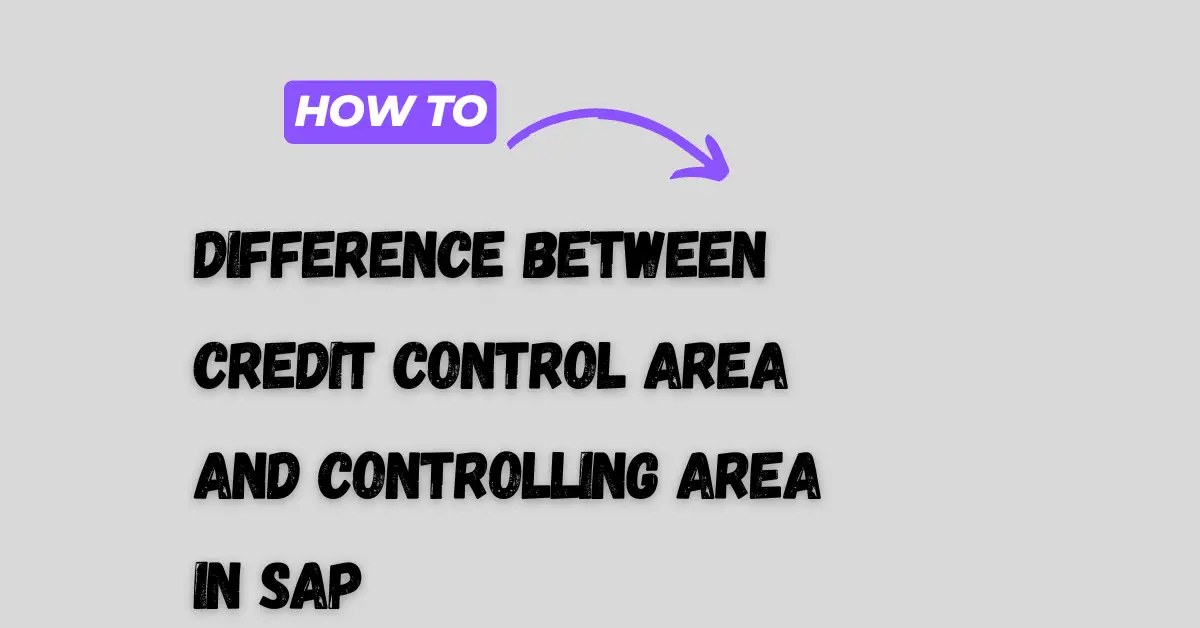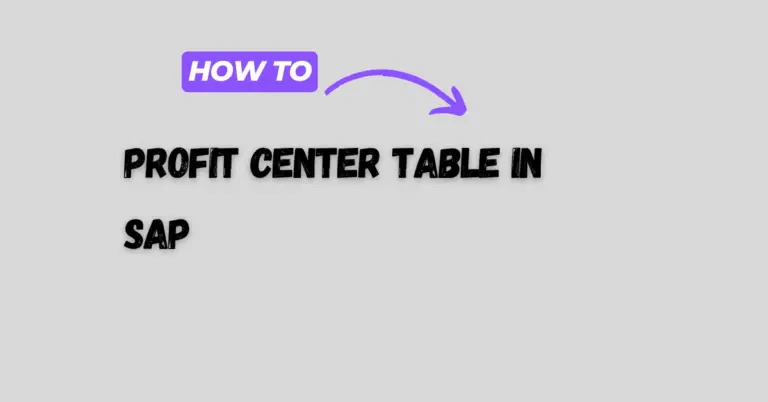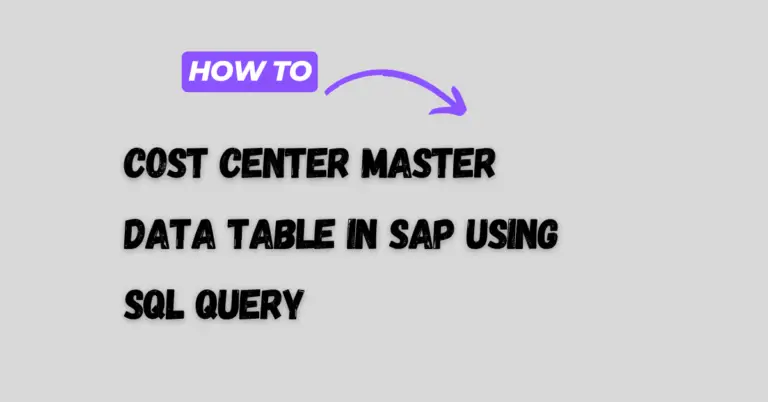Understanding the Difference Between Credit Control Area and Controlling Area in SAP
When diving into SAP, especially if you’re new to the system, the terms “Credit Control Area” and “Controlling Area” can be quite confusing. Both are fundamental concepts within SAP’s Financial Accounting (FI) and Controlling (CO) modules, and understanding their differences is crucial for effectively managing financial data in SAP.

What is a Controlling Area in SAP?
A Controlling Area in SAP is a key organizational unit within the Controlling (CO) module. It represents a distinct entity where internal accounting and reporting processes are managed. Essentially, a Controlling Area allows businesses to capture and analyze internal costs and revenues, providing insights into the profitability and financial performance of different segments of the business.
In simple terms, think of a Controlling Area as the space where all the internal financial data related to cost centers, profit centers, and internal orders is gathered and analyzed. It serves as the backbone of internal financial management in SAP.
What is a Credit Control Area?
On the other hand, a Credit Control Area in SAP belongs to the Financial Accounting (FI) module. It is primarily concerned with the external aspect of financial management, focusing on credit management for customers. A Credit Control Area ensures that a company’s exposure to credit risk is within predefined limits.
In practice, this means the Credit Control Area helps the business monitor and control customer credit limits across various sales transactions. If a customer’s credit exceeds the set limit, SAP can automatically block further sales orders until the outstanding balance is settled.
Key Differences Between Credit Control Area and Controlling Area in SAP
- Purpose:
- The Controlling Area in SAP is used for internal accounting and reporting, focusing on cost and revenue management within the organization.
- The Credit Control Area is used for managing customer credit and mitigating financial risk associated with credit sales.
- Module:
- The Controlling Area is part of the Controlling (CO) module, dealing with internal financial operations.
- The Credit Control Area is part of the Financial Accounting (FI) module, dealing with external financial operations related to customer credit.
- Scope:
- A Controlling Area can cover multiple company codes (entities within a business) for internal reporting purposes.
- A Credit Control Area can also cover multiple company codes but is strictly focused on credit management.
- Data Relationship:
- In a Controlling Area, you manage cost centers, profit centers, internal orders, etc. It’s closely linked with the company’s internal structure.
- In a Credit Control Area, you manage customer credit limits and their exposure, closely linked with customer data and sales processes.
Why Understanding This Difference Matters
For anyone new to SAP, grasping the distinction between a Controlling Area in SAP and a Credit Control Area is essential because they serve different purposes and are critical to different aspects of financial management. Mixing them up can lead to misconfigurations and misinterpretations of financial data, which could impact the accuracy of both internal reporting and external credit management.
How to Create a Controlling Area in SAP
If you’re setting up a Controlling Area in SAP for the first time, it’s essential to follow the correct process. This will ensure proper internal accounting and reporting for your organization.
To create a Controlling Area in SAP, follow these steps:
- Access SAP Transaction:
- Go to the SAP transaction code OKKP (Customizing of Controlling Area). This is where you can manage the configuration for controlling areas.
- Enter the Basic Data:
- In this screen, you will need to fill in the basic details such as:
- Controlling Area: Choose a four-character ID that uniquely identifies the controlling area.
- Name: Give a descriptive name to your controlling area (e.g., “North America Division”).
- Currency: Set the controlling area’s currency. This is important because all internal reports and data will use this currency.
- Fiscal Year Variant: Define how the fiscal year will be divided (for example, 12 months, 4 quarters, etc.).
- In this screen, you will need to fill in the basic details such as:
- Assign Company Codes:
- A Controlling Area in SAP can be assigned to one or more company codes. A company code represents an individual legal entity within your organization. You must assign the company codes relevant to the controlling area you’re creating.
- Make sure the fiscal year variant and chart of accounts between the controlling area and the assigned company codes are compatible.
- Cost Center and Profit Center Settings:
- Specify whether you want to enable cost center accounting, profit center accounting, or other internal accounting methods. This will depend on how your business needs to manage internal costs and revenues.
- Save and Activate:
- Once all the details are filled out, save your configuration. The controlling area is now created and can be used for internal financial reporting and analysis.
Tips for Setting Up a Controlling Area in SAP
- Consistency is Key: Ensure that the currency, fiscal year, and chart of accounts are consistent across the company codes you assign to a controlling area. This avoids mismatches and reporting issues.
- Single or Multiple Controlling Areas: Depending on your organization’s structure, you can either have one Controlling Area in SAP that covers multiple company codes, or multiple controlling areas. The choice depends on how centralized or decentralized your financial operations are.
Learn more about the usage of controlling area currency in SAP?
SQL Examples
Here are some SQL examples that could be relevant when working with the Controlling Area in SAP. These queries assume that you have a database with SAP-like tables for managing controlling areas, cost centers, and related data.
Example 1: Retrieve All Controlling Areas
This query lists all the controlling areas defined in the system.
SELECT
CONTROLLING_AREA,
NAME,
CURRENCY,
FISCAL_YEAR_VARIANT
FROM
CONTROLLING_AREA_TABLE;
By following these steps, you can easily create and manage a Controlling Area in SAP that meets your organization’s internal financial needs.
Example 2: List Company Codes Assigned to a Specific Controlling Area
This query returns all company codes associated with a specific controlling area.
SELECT
COMPANY_CODE,
COMPANY_NAME
FROM
COMPANY_CODE_TABLE
WHERE
CONTROLLING_AREA = 'XXXX'; -- Replace 'XXXX' with your controlling area ID
Example 3: Retrieve All Cost Centers Under a Specific Controlling Area
This query retrieves all cost centers assigned to a particular controlling area.
SELECT
COST_CENTER,
COST_CENTER_NAME,
CONTROLLING_AREA
FROM
COST_CENTER_TABLE
WHERE
CONTROLLING_AREA = 'XXXX'; -- Replace 'XXXX' with your controlling area ID
Example 4: Sum of Costs by Cost Center within a Controlling Area
This query calculates the total costs recorded under each cost center within a specific controlling area.
SELECT
COST_CENTER,
SUM(COST_AMOUNT) AS TOTAL_COST
FROM
COST_CENTER_DATA
WHERE
CONTROLLING_AREA = 'XXXX' -- Replace 'XXXX' with your controlling area ID
GROUP BY
COST_CENTER;
Example 5: Fetch Profit Centers Linked to a Controlling Area
This query retrieves all profit centers associated with a specific controlling area.
SELECT
PROFIT_CENTER,
PROFIT_CENTER_NAME
FROM
PROFIT_CENTER_TABLE
WHERE
CONTROLLING_AREA = 'XXXX'; -- Replace 'XXXX' with your controlling area ID
Example 6: Inner Join Between Controlling Area and Company Codes
This query joins the Controlling Area table with the Company Code table to show which company codes are linked to which controlling areas.
SELECT
CA.CONTROLLING_AREA,
CA.NAME AS CONTROLLING_AREA_NAME,
CC.COMPANY_CODE,
CC.COMPANY_NAME
FROM
CONTROLLING_AREA_TABLE CA
INNER JOIN
COMPANY_CODE_TABLE CC
ON
CA.CONTROLLING_AREA = CC.CONTROLLING_AREA;
Example 7: Count the Number of Cost Centers in Each Controlling Area
This query counts the number of cost centers assigned to each controlling area.
SELECT
CONTROLLING_AREA,
COUNT(COST_CENTER) AS NUMBER_OF_COST_CENTERS
FROM
COST_CENTER_TABLE
GROUP BY
CONTROLLING_AREA;
Retrieve Cost Center Balances
This query retrieves the total actual costs and planned costs for each cost center within a specific controlling area.
SELECT
COST_CENTER,
CONTROLLING_AREA,
SUM(ACTUAL_COST) AS TOTAL_ACTUAL_COST,
SUM(PLANNED_COST) AS TOTAL_PLANNED_COST
FROM
COST_CENTER_DATA
WHERE
CONTROLLING_AREA = 'XXXX' -- Replace 'XXXX' with your controlling area ID
GROUP BY
COST_CENTER,
CONTROLLING_AREA;
List All Internal Orders and Their Status
This query lists all internal orders within a controlling area, including their description and current status (e.g., released, closed).
SELECT
INTERNAL_ORDER,
ORDER_DESCRIPTION,
ORDER_STATUS
FROM
INTERNAL_ORDER_TABLE
WHERE
CONTROLLING_AREA = 'XXXX'; -- Replace 'XXXX' with your controlling area ID
Retrieve Cost Elements by Cost Center
This query provides a detailed breakdown of costs by cost element within a specific cost center.
SELECT
COST_CENTER,
COST_ELEMENT,
COST_ELEMENT_DESCRIPTION,
SUM(ACTUAL_COST) AS TOTAL_ACTUAL_COST
FROM
COST_CENTER_COST_ELEMENT
WHERE
COST_CENTER = 'YYYY' -- Replace 'YYYY' with your cost center ID
GROUP BY
COST_CENTER,
COST_ELEMENT,
COST_ELEMENT_DESCRIPTION;
Analyze Variances Between Actual and Planned Costs
This query calculates the variance between actual and planned costs for each cost center in a specific controlling area.
SELECT
COST_CENTER,
SUM(ACTUAL_COST - PLANNED_COST) AS VARIANCE
FROM
COST_CENTER_DATA
WHERE
CONTROLLING_AREA = 'XXXX' -- Replace 'XXXX' with your controlling area ID
GROUP BY
COST_CENTER;
Extract Profit Center Data
This query extracts all profit centers within a controlling area along with their associated revenue and cost data.
SELECT
PROFIT_CENTER,
PROFIT_CENTER_DESCRIPTION,
SUM(REVENUE) AS TOTAL_REVENUE,
SUM(COST) AS TOTAL_COST
FROM
PROFIT_CENTER_DATA
WHERE
CONTROLLING_AREA = 'XXXX' -- Replace 'XXXX' with your controlling area ID
GROUP BY
PROFIT_CENTER,
PROFIT_CENTER_DESCRIPTION;
Fetch Open Internal Orders with No Actual Costs
This query lists internal orders that have been created but have not yet incurred any actual costs.
SELECT
INTERNAL_ORDER,
ORDER_DESCRIPTION
FROM
INTERNAL_ORDER_TABLE
WHERE
CONTROLLING_AREA = 'XXXX' -- Replace 'XXXX' with your controlling area ID
AND ACTUAL_COST = 0;
Retrieve Cost Center Hierarchy
This query retrieves the hierarchy structure of cost centers within a controlling area, showing parent and child relationships.
SELECT
PARENT_COST_CENTER,
CHILD_COST_CENTER
FROM
COST_CENTER_HIERARCHY
WHERE
CONTROLLING_AREA = 'XXXX'; -- Replace 'XXXX' with your controlling area ID
Calculate Total Allocated Costs by Cost Center
This query sums up the total allocated costs (e.g., costs that have been distributed from one cost center to others) for each cost center.
SELECT
COST_CENTER,
SUM(ALLOCATED_COST) AS TOTAL_ALLOCATED_COST
FROM
COST_ALLOCATION_TABLE
WHERE
CONTROLLING_AREA = 'XXXX' -- Replace 'XXXX' with your controlling area ID
GROUP BY
COST_CENTER;
List Top 10 Cost Centers by Actual Cost
This query identifies the top 10 cost centers by total actual cost within a controlling area.
SELECT
COST_CENTER,
COST_CENTER_DESCRIPTION,
SUM(ACTUAL_COST) AS TOTAL_ACTUAL_COST
FROM
COST_CENTER_DATA
WHERE
CONTROLLING_AREA = 'XXXX' -- Replace 'XXXX' with your controlling area ID
GROUP BY
COST_CENTER,
COST_CENTER_DESCRIPTION
ORDER BY
TOTAL_ACTUAL_COST DESC
LIMIT 10;
In summary, while both concepts are crucial, they play distinct roles within SAP’s comprehensive financial ecosystem. The Controlling Area in SAP focuses on internal financial tracking, while the Credit Control Area manages external credit-related risks. Understanding these roles will help you navigate SAP more effectively and ensure that your financial data is accurately managed.
By mastering these concepts, you’ll be well on your way to understanding the broader SAP system and how it helps businesses maintain financial control and transparency.
Learn about the cleared and open items in SAP




2 Comments
Comments are closed.